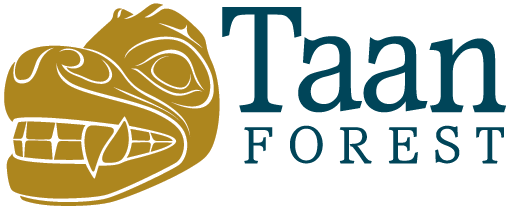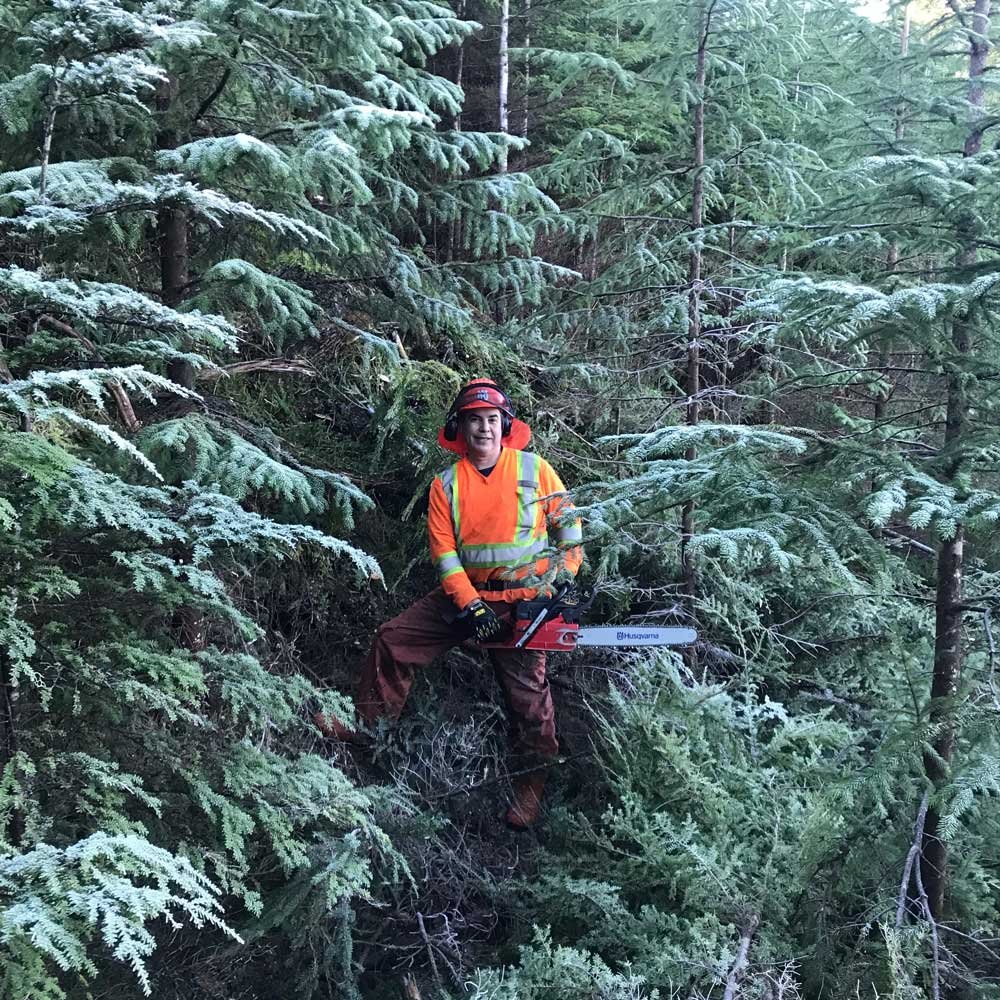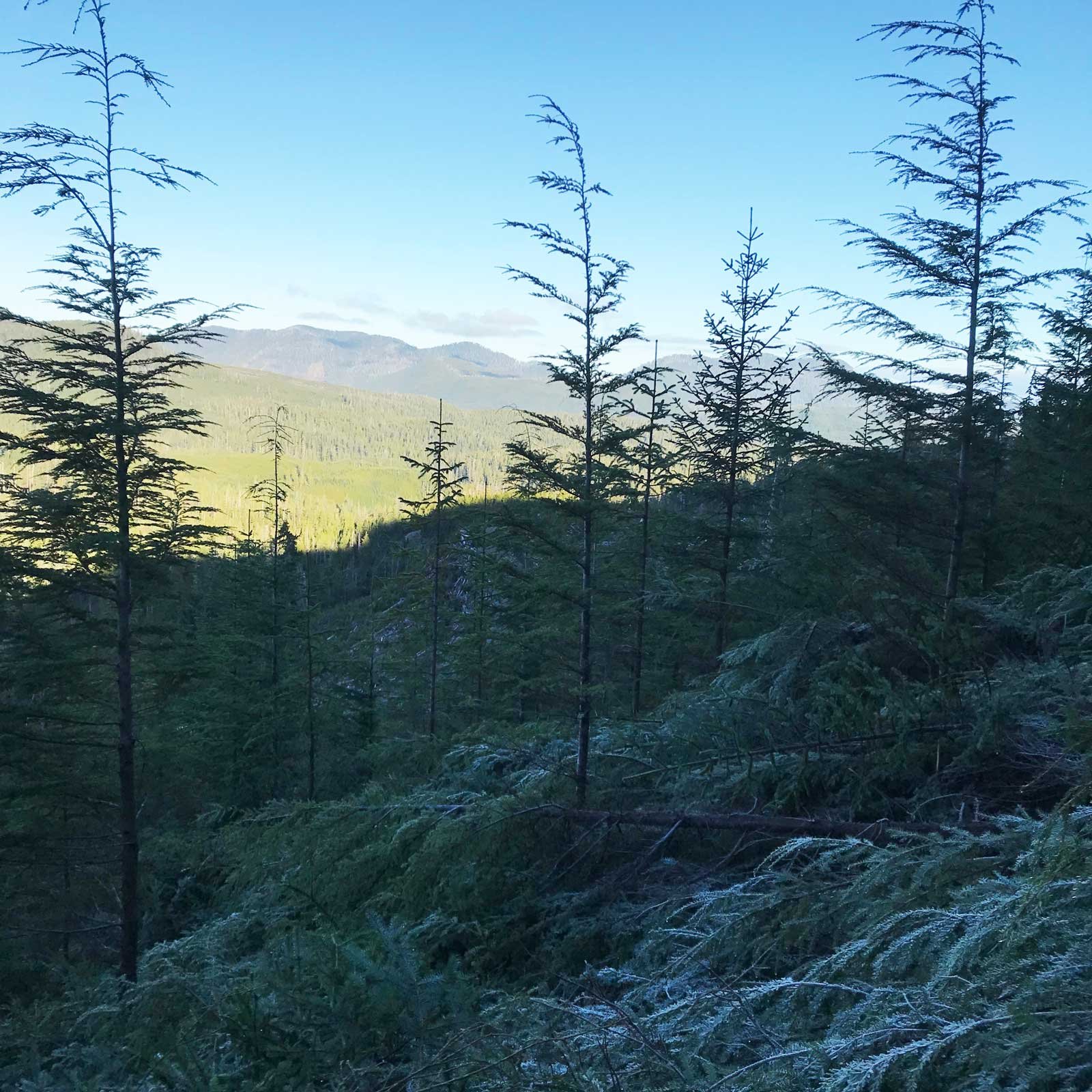Taan Projects
Taan Forest is committed to create a successful forest business and economy on Haida Gwaii based on the management objectives of the Haida Gwaii Land Use Objectives Order (HGLUOO). Unique to this order are the management of cultural heritage and forest features, culturally significant wildlife, significant protection of fish bearing waters in addition to principles of Ecosystem Based Management.
Our goal is to meet or exceeding the Land Use Objectives Order while incorporating the Haida Principle of Yahguudang respect for all living thingsand Haida values such as Ts’uu/SGaahlan cedar, Chiina salmon, Taan black bear, Adiidsii ga xil iinasdll plants, Xidid birds and Chiixwaay beaches to name a few.
To help meet our commitment and goal we have been working towards a permanent silviculture crew on Xaayda Gwaay.yaay Haida Gwaii comprised of members of the Haida Nation. Over the last year, with funding from Forest Enhancement Society of British Columbia, we have been working on projects including:
Riparian Restoration for wildlife, including, salmon, black bear and raptors
Juvenile spacing for wildlife including raptors and black bear use
First Lift Prune spacing stands for wildlife including raptors
Individual tree fertilization of cedar for enhancing carbon sequestration and cultural use of cedar
RIPARIAN RESTORATION
The plan for this project is multi-year, however the first phase is ready to start early in 2019. A significant investment has already been made for planning and development of treatment for these stands. Funding for the initial stages came through Recreational Fisheries Conservation Partnership Program (RFCPP), Old Massett Band Council (OMVC) and in-kind contributions from Taan Forest including, site selection, environmental awareness training of crews, Stand Management Prescription review and recommendations. The primary objective of this project is for benefit to wildlife such as Chiina salmon and other Chiina fish, however a spin-off of the project is benefits to Stad K’un goshawk, Taan black bear, Guud eagles, St’aw.was saw whet owls, GudGaadu gamhlGal bats and many other resident and migratory Xidid birds.
While riparian restoration can generally focus on in stream work and lower bench stabilization, the Haida Nation has concerns over any work conducted on the lower bench of large waterways, such as the Yaagun Gandlaay Yakoun River (the project focus). This project will be concentrated on the mid and high benches. These benches fall within the HGLUOO protected areas for fish habitat and 100 year flood plain. These benches are also red and blue listed ecosystems and again protected in the HGLUOO through Ecosystem Based Management.
Spacing, creation of snags and initial introduction of coarse woody debris is the goal of the project to begin mimicking the natural processes of riparian areas. Through spacing, trees are released from competition and able to grow faster and develop for soil stabilization and eventual large coarse woody debris introduction. Spacing slash will act as temporary coarse woody debris, snags will act as wildlife habitat and eventual coarse woody debris for interim introduction between spacing slash and large coarse woody debris of the developing stand.
Some areas in these mid and higher benches will require some planting of conifer species where the over story is currently deciduous (alder).
JUVENILE SPACING AND PRUNING
Taan Forest currently has 27 hectares of spacing laid out and under prescription and another 120 hectares currently in layout progress.
These two locations are located within the forage areas of the Stads K’un goshawk
PHT4 is located within the Ghost Stads K’un goshawk territory
Drill is located within the Three Mile Stads K’un goshawk Territory
Spacing and Pruning within these forage areas is expected to enhance wildlife habitat including Stads K’un goshawk forage habitat by achieving the following:
Reducing stems close to a mature stand density
Creating open flight paths between trees for Stads K’un goshawk, GudGaadu gamhlGal bats, migratory and resident Xidid birds
Temporarily introducing light to the understory for brush and berry development for Stads K’un goshawk prey forage
Allowing access for Taan black bear to forage and seek denning opportunities otherwise impeded by the stand density
FIRST LIFT PRUNE
Significant to Haida Gwaii is the Haida Nation’s National bird, Stads K’un Goshawk, a subspecies of the Northern Goshawk specific to Haida Gwaii. Silviculture practices to enhance growth, habitat and mimic mature/Old Growth attributes will be a benefit to the Stads K’un goshawk. Several of the riparian sites and the spacing and pruning sites fall within known Stads K’un goshawk foraging areas.
Stads K’un Goshawk prefer mature stands of Spruce and Hemlock on Haida Gwaii to hunt. Part of our wildlife enhancement management of the riparian and spacing/pruning stands is to reduce the time to create preferred foraging stands for Stads K’un goshawk. This will be completed in riparian and spacing stands by reducing stems per hectare down to what is typical of a mature stand, releasing stems to express dominance in a shorter time frame and temporarily allowing more light to reach the forest floor for shrub and berry growth for Stads K’un goshawk prey forage.
First lift Pruning is anticipated to enhance Stads K’un goshawk forage as well by beginning to create a clear understory for goshawk to maneuver and hunt under the canopy as they prefer to do. Clear understory and flight paths are also a benefit to several other Xidid birds and GudGaadu gamhlGal bats as well.
FERTILIZATION
Haida Gwaii is well known for its Ts’uu Red and SGaahlan Yellow cedar. The high demand is because of Ts’uu/SGaahlan cedars look but most importantly it’s resistance to rot and longevity compared to other woods. Due to rot resistance and longevity, it has the capability of storing carbon much longer than many other species of wood.
Ts’uu/SGaahlan cedar on Xaayda Gwaay.yaay Haida Gwaii is particularly difficult to re-establish because of K’aad deer browse. Taan Forest has invested significantly to protect Ts’uu/SGaahlan cedar from browse. Once the height of cedar is above browse height, it is important to ensure the tree makes it to be the dominant or co-dominant tree(s) in the new forest stand.
Once browse protectors are removed fertilization of individual stems with Nitrogen and small amounts of Potassium and Phosphate can give the tree the boost it needs to establish itself within the canopy of the new stand.
Hand fertilization is preferred for direct application to the cedar. While Ts’uu/SGaahlan cedar stands are not preferred forage areas for Stads k'un goshawk, they do utilize these stands. A benefit of fertilizing Ts’uu/SGaahlan cedar stands is to speed the growth of the tree to mimic a mature stand for Stads K’un goshawk forage.
Fertilization of Ts’uu/SGaahlan cedar stands will increase growth and shorten time frames for the stand to have trees and logs that can be utilized the Taan black bear for denning sites.




